Commercial Law: Rights to Sue in Tort of Negligence and Australian Consumer Law
VerifiedAdded on 2022/11/14
|11
|2902
|193
AI Summary
This document discusses the rights of Priya and Rahul to sue under the tort of negligence and Australian Consumer Law. It covers the essential elements of negligence and the provisions of the Australian Consumer Law. The document also includes a summary of the case, subject, and course code.
Contribute Materials
Your contribution can guide someone’s learning journey. Share your
documents today.
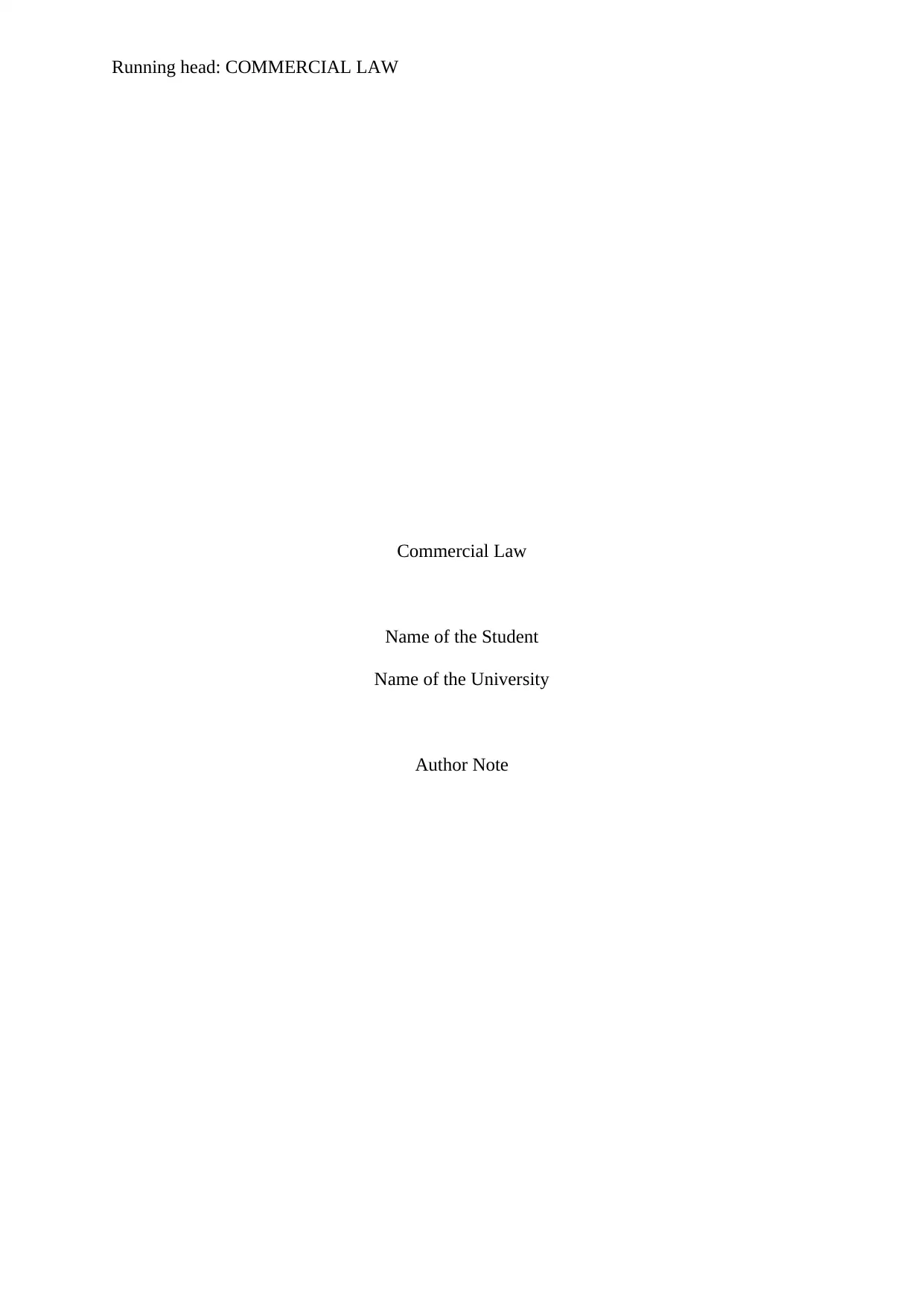
Running head: COMMERCIAL LAW
Commercial Law
Name of the Student
Name of the University
Author Note
Commercial Law
Name of the Student
Name of the University
Author Note
Secure Best Marks with AI Grader
Need help grading? Try our AI Grader for instant feedback on your assignments.
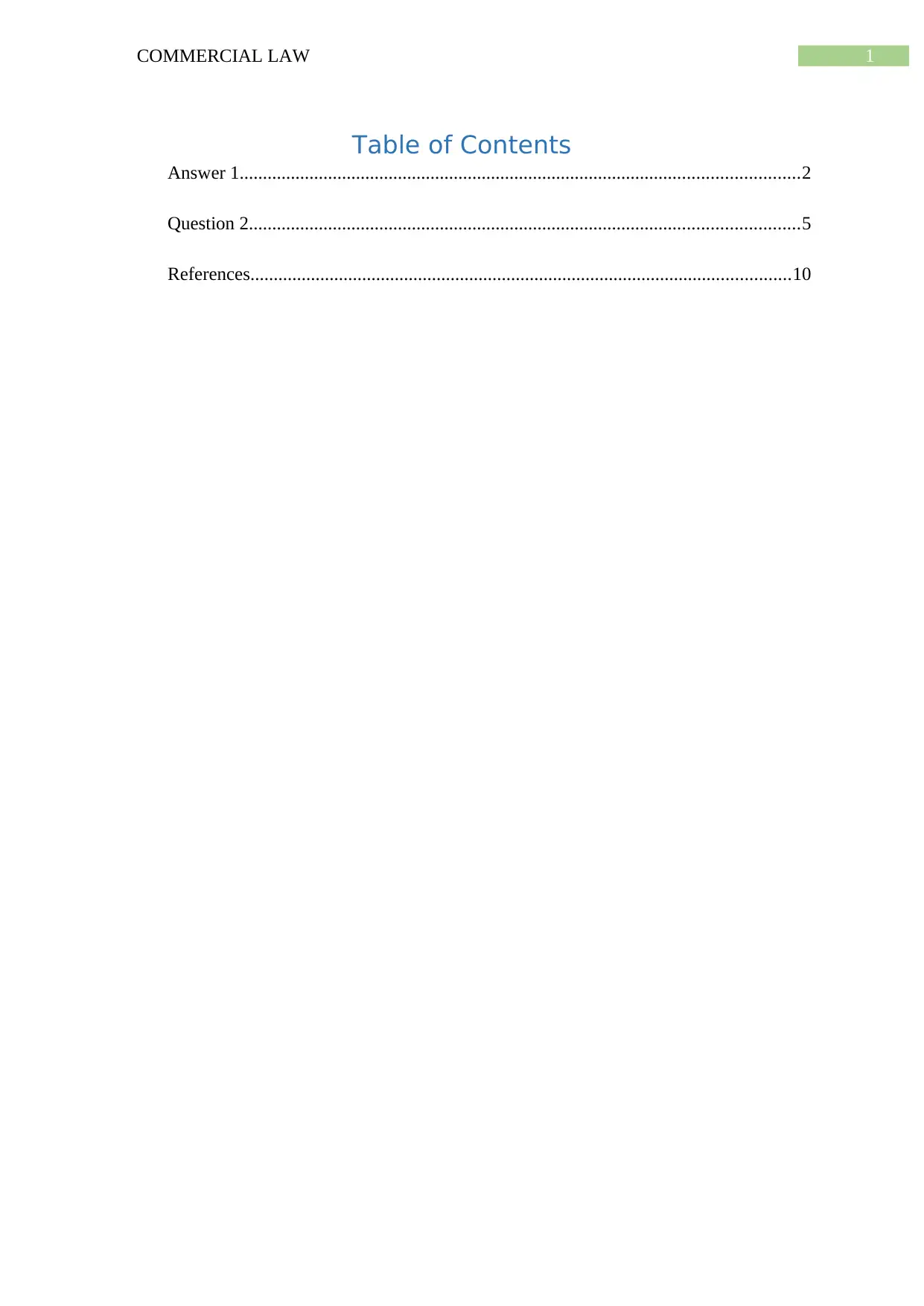
1COMMERCIAL LAW
Table of Contents
Answer 1........................................................................................................................2
Question 2......................................................................................................................5
References....................................................................................................................10
Table of Contents
Answer 1........................................................................................................................2
Question 2......................................................................................................................5
References....................................................................................................................10
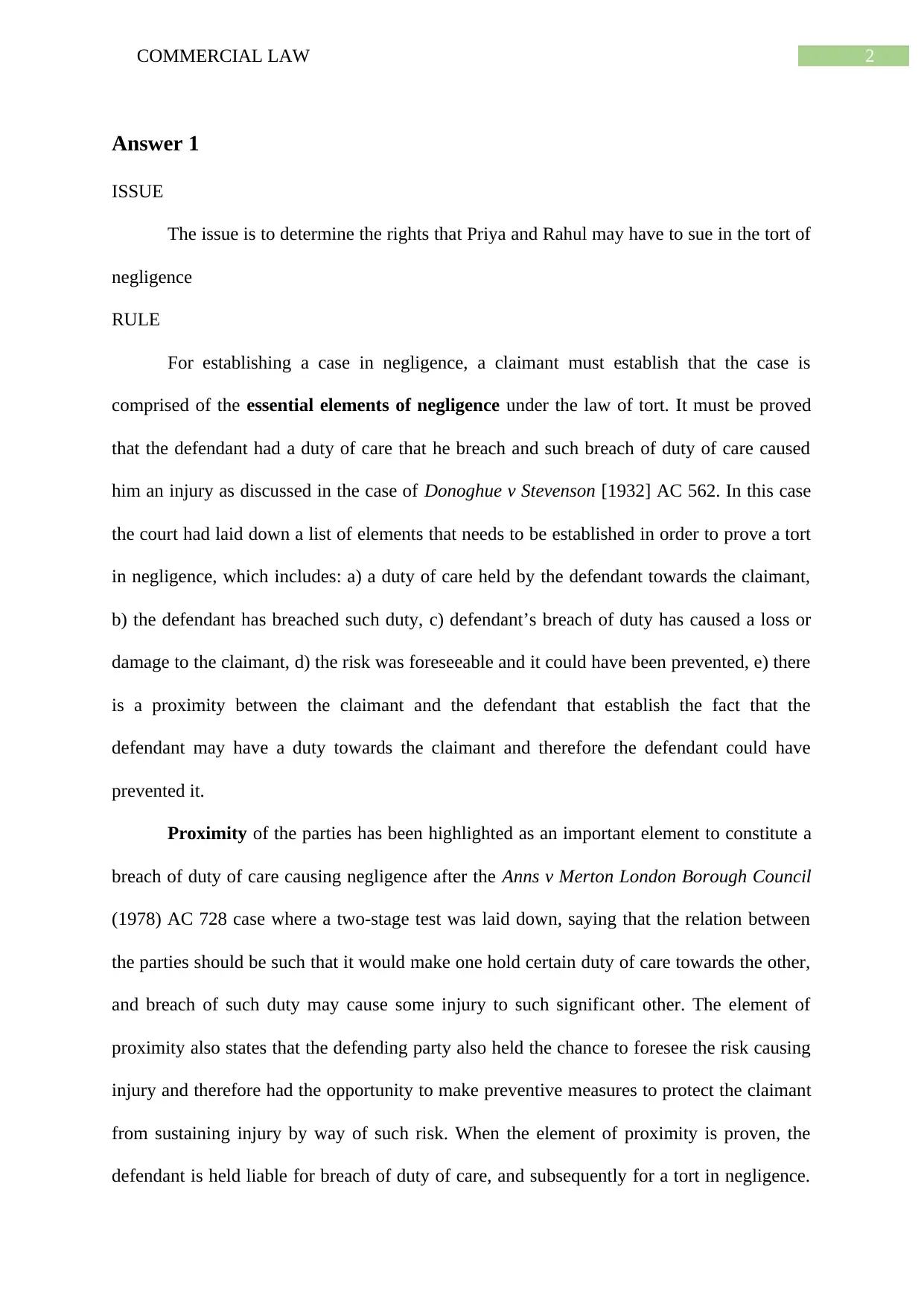
2COMMERCIAL LAW
Answer 1
ISSUE
The issue is to determine the rights that Priya and Rahul may have to sue in the tort of
negligence
RULE
For establishing a case in negligence, a claimant must establish that the case is
comprised of the essential elements of negligence under the law of tort. It must be proved
that the defendant had a duty of care that he breach and such breach of duty of care caused
him an injury as discussed in the case of Donoghue v Stevenson [1932] AC 562. In this case
the court had laid down a list of elements that needs to be established in order to prove a tort
in negligence, which includes: a) a duty of care held by the defendant towards the claimant,
b) the defendant has breached such duty, c) defendant’s breach of duty has caused a loss or
damage to the claimant, d) the risk was foreseeable and it could have been prevented, e) there
is a proximity between the claimant and the defendant that establish the fact that the
defendant may have a duty towards the claimant and therefore the defendant could have
prevented it.
Proximity of the parties has been highlighted as an important element to constitute a
breach of duty of care causing negligence after the Anns v Merton London Borough Council
(1978) AC 728 case where a two-stage test was laid down, saying that the relation between
the parties should be such that it would make one hold certain duty of care towards the other,
and breach of such duty may cause some injury to such significant other. The element of
proximity also states that the defending party also held the chance to foresee the risk causing
injury and therefore had the opportunity to make preventive measures to protect the claimant
from sustaining injury by way of such risk. When the element of proximity is proven, the
defendant is held liable for breach of duty of care, and subsequently for a tort in negligence.
Answer 1
ISSUE
The issue is to determine the rights that Priya and Rahul may have to sue in the tort of
negligence
RULE
For establishing a case in negligence, a claimant must establish that the case is
comprised of the essential elements of negligence under the law of tort. It must be proved
that the defendant had a duty of care that he breach and such breach of duty of care caused
him an injury as discussed in the case of Donoghue v Stevenson [1932] AC 562. In this case
the court had laid down a list of elements that needs to be established in order to prove a tort
in negligence, which includes: a) a duty of care held by the defendant towards the claimant,
b) the defendant has breached such duty, c) defendant’s breach of duty has caused a loss or
damage to the claimant, d) the risk was foreseeable and it could have been prevented, e) there
is a proximity between the claimant and the defendant that establish the fact that the
defendant may have a duty towards the claimant and therefore the defendant could have
prevented it.
Proximity of the parties has been highlighted as an important element to constitute a
breach of duty of care causing negligence after the Anns v Merton London Borough Council
(1978) AC 728 case where a two-stage test was laid down, saying that the relation between
the parties should be such that it would make one hold certain duty of care towards the other,
and breach of such duty may cause some injury to such significant other. The element of
proximity also states that the defending party also held the chance to foresee the risk causing
injury and therefore had the opportunity to make preventive measures to protect the claimant
from sustaining injury by way of such risk. When the element of proximity is proven, the
defendant is held liable for breach of duty of care, and subsequently for a tort in negligence.
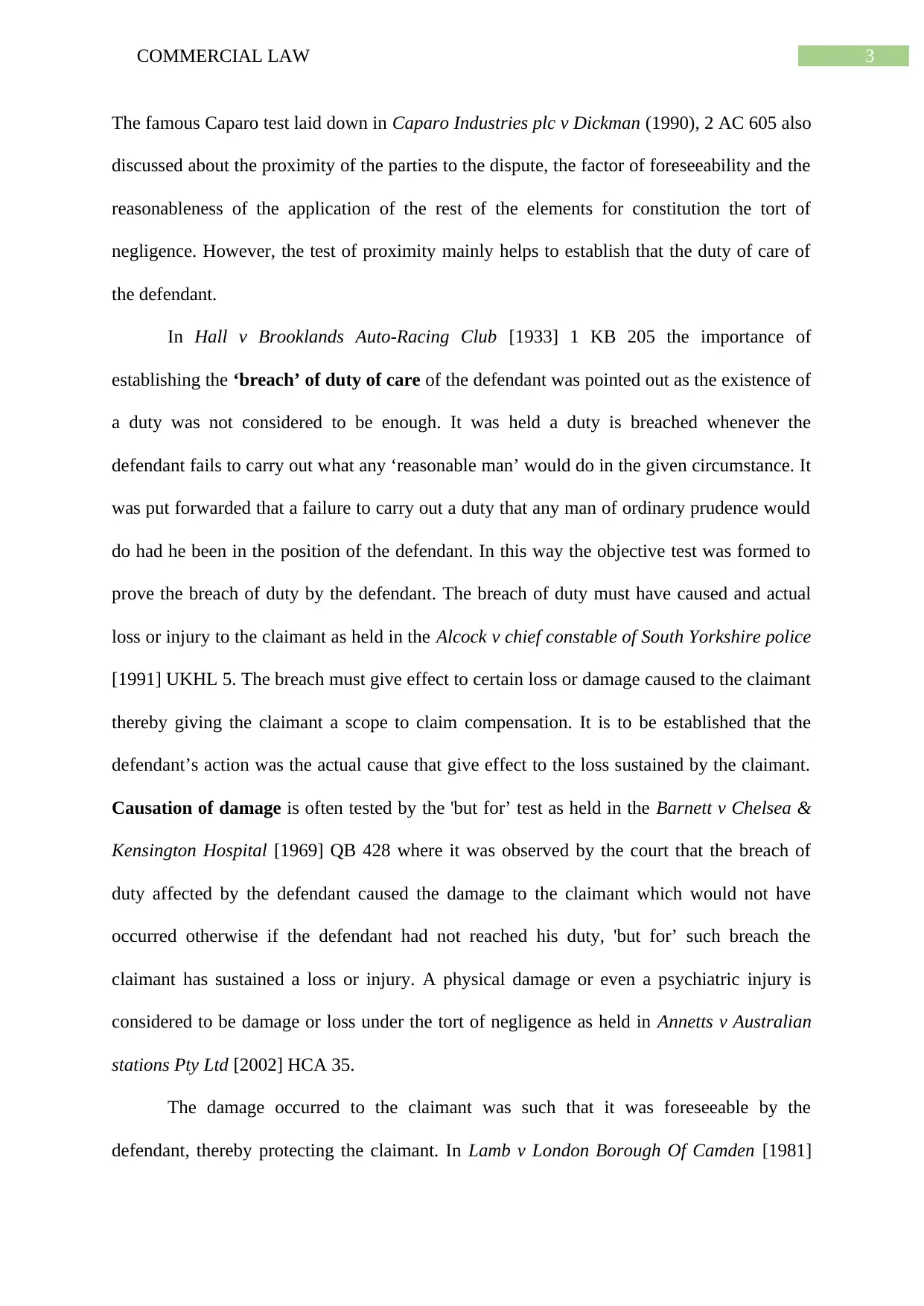
3COMMERCIAL LAW
The famous Caparo test laid down in Caparo Industries plc v Dickman (1990), 2 AC 605 also
discussed about the proximity of the parties to the dispute, the factor of foreseeability and the
reasonableness of the application of the rest of the elements for constitution the tort of
negligence. However, the test of proximity mainly helps to establish that the duty of care of
the defendant.
In Hall v Brooklands Auto-Racing Club [1933] 1 KB 205 the importance of
establishing the ‘breach’ of duty of care of the defendant was pointed out as the existence of
a duty was not considered to be enough. It was held a duty is breached whenever the
defendant fails to carry out what any ‘reasonable man’ would do in the given circumstance. It
was put forwarded that a failure to carry out a duty that any man of ordinary prudence would
do had he been in the position of the defendant. In this way the objective test was formed to
prove the breach of duty by the defendant. The breach of duty must have caused and actual
loss or injury to the claimant as held in the Alcock v chief constable of South Yorkshire police
[1991] UKHL 5. The breach must give effect to certain loss or damage caused to the claimant
thereby giving the claimant a scope to claim compensation. It is to be established that the
defendant’s action was the actual cause that give effect to the loss sustained by the claimant.
Causation of damage is often tested by the 'but for’ test as held in the Barnett v Chelsea &
Kensington Hospital [1969] QB 428 where it was observed by the court that the breach of
duty affected by the defendant caused the damage to the claimant which would not have
occurred otherwise if the defendant had not reached his duty, 'but for’ such breach the
claimant has sustained a loss or injury. A physical damage or even a psychiatric injury is
considered to be damage or loss under the tort of negligence as held in Annetts v Australian
stations Pty Ltd [2002] HCA 35.
The damage occurred to the claimant was such that it was foreseeable by the
defendant, thereby protecting the claimant. In Lamb v London Borough Of Camden [1981]
The famous Caparo test laid down in Caparo Industries plc v Dickman (1990), 2 AC 605 also
discussed about the proximity of the parties to the dispute, the factor of foreseeability and the
reasonableness of the application of the rest of the elements for constitution the tort of
negligence. However, the test of proximity mainly helps to establish that the duty of care of
the defendant.
In Hall v Brooklands Auto-Racing Club [1933] 1 KB 205 the importance of
establishing the ‘breach’ of duty of care of the defendant was pointed out as the existence of
a duty was not considered to be enough. It was held a duty is breached whenever the
defendant fails to carry out what any ‘reasonable man’ would do in the given circumstance. It
was put forwarded that a failure to carry out a duty that any man of ordinary prudence would
do had he been in the position of the defendant. In this way the objective test was formed to
prove the breach of duty by the defendant. The breach of duty must have caused and actual
loss or injury to the claimant as held in the Alcock v chief constable of South Yorkshire police
[1991] UKHL 5. The breach must give effect to certain loss or damage caused to the claimant
thereby giving the claimant a scope to claim compensation. It is to be established that the
defendant’s action was the actual cause that give effect to the loss sustained by the claimant.
Causation of damage is often tested by the 'but for’ test as held in the Barnett v Chelsea &
Kensington Hospital [1969] QB 428 where it was observed by the court that the breach of
duty affected by the defendant caused the damage to the claimant which would not have
occurred otherwise if the defendant had not reached his duty, 'but for’ such breach the
claimant has sustained a loss or injury. A physical damage or even a psychiatric injury is
considered to be damage or loss under the tort of negligence as held in Annetts v Australian
stations Pty Ltd [2002] HCA 35.
The damage occurred to the claimant was such that it was foreseeable by the
defendant, thereby protecting the claimant. In Lamb v London Borough Of Camden [1981]
Secure Best Marks with AI Grader
Need help grading? Try our AI Grader for instant feedback on your assignments.
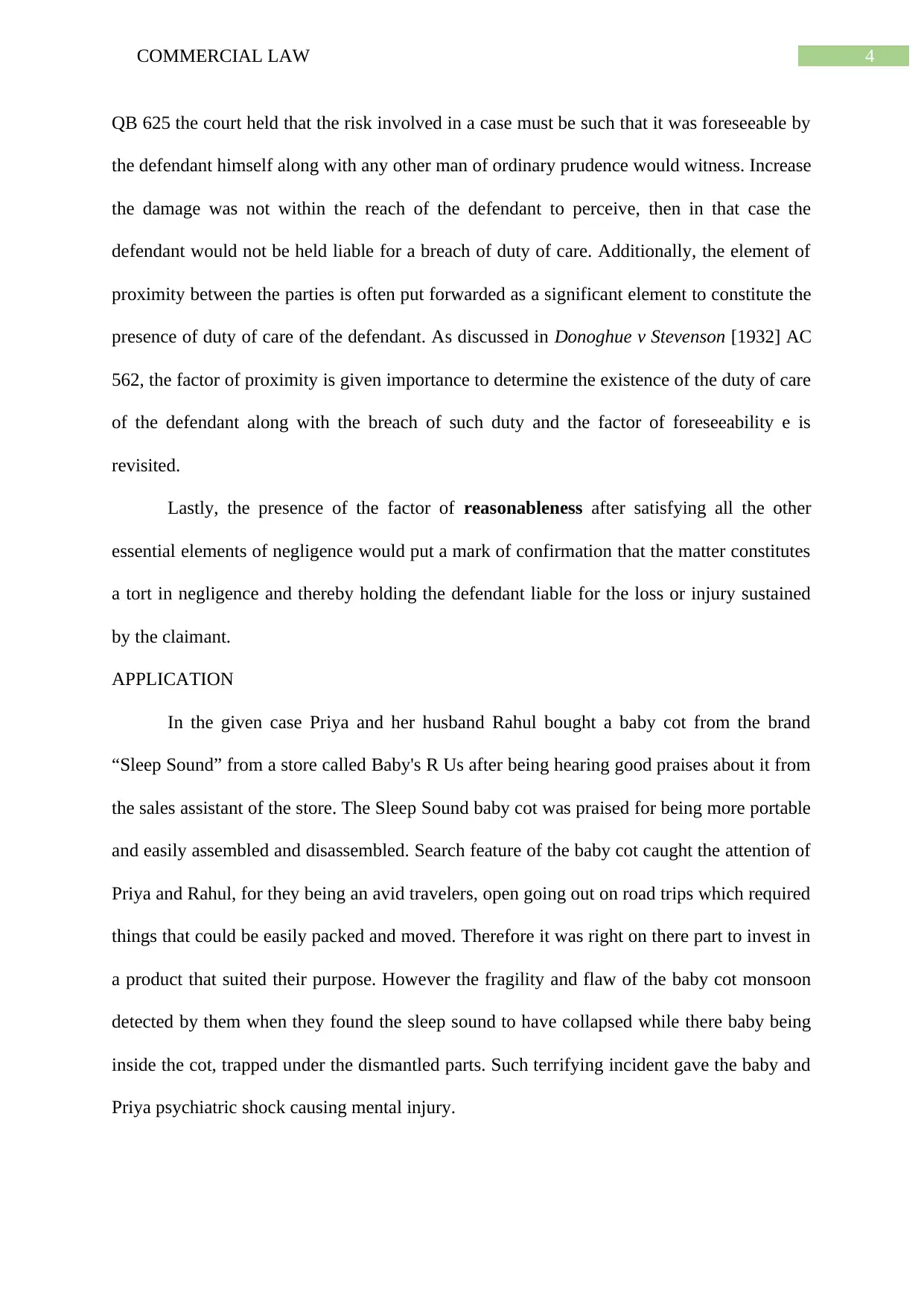
4COMMERCIAL LAW
QB 625 the court held that the risk involved in a case must be such that it was foreseeable by
the defendant himself along with any other man of ordinary prudence would witness. Increase
the damage was not within the reach of the defendant to perceive, then in that case the
defendant would not be held liable for a breach of duty of care. Additionally, the element of
proximity between the parties is often put forwarded as a significant element to constitute the
presence of duty of care of the defendant. As discussed in Donoghue v Stevenson [1932] AC
562, the factor of proximity is given importance to determine the existence of the duty of care
of the defendant along with the breach of such duty and the factor of foreseeability e is
revisited.
Lastly, the presence of the factor of reasonableness after satisfying all the other
essential elements of negligence would put a mark of confirmation that the matter constitutes
a tort in negligence and thereby holding the defendant liable for the loss or injury sustained
by the claimant.
APPLICATION
In the given case Priya and her husband Rahul bought a baby cot from the brand
“Sleep Sound” from a store called Baby's R Us after being hearing good praises about it from
the sales assistant of the store. The Sleep Sound baby cot was praised for being more portable
and easily assembled and disassembled. Search feature of the baby cot caught the attention of
Priya and Rahul, for they being an avid travelers, open going out on road trips which required
things that could be easily packed and moved. Therefore it was right on there part to invest in
a product that suited their purpose. However the fragility and flaw of the baby cot monsoon
detected by them when they found the sleep sound to have collapsed while there baby being
inside the cot, trapped under the dismantled parts. Such terrifying incident gave the baby and
Priya psychiatric shock causing mental injury.
QB 625 the court held that the risk involved in a case must be such that it was foreseeable by
the defendant himself along with any other man of ordinary prudence would witness. Increase
the damage was not within the reach of the defendant to perceive, then in that case the
defendant would not be held liable for a breach of duty of care. Additionally, the element of
proximity between the parties is often put forwarded as a significant element to constitute the
presence of duty of care of the defendant. As discussed in Donoghue v Stevenson [1932] AC
562, the factor of proximity is given importance to determine the existence of the duty of care
of the defendant along with the breach of such duty and the factor of foreseeability e is
revisited.
Lastly, the presence of the factor of reasonableness after satisfying all the other
essential elements of negligence would put a mark of confirmation that the matter constitutes
a tort in negligence and thereby holding the defendant liable for the loss or injury sustained
by the claimant.
APPLICATION
In the given case Priya and her husband Rahul bought a baby cot from the brand
“Sleep Sound” from a store called Baby's R Us after being hearing good praises about it from
the sales assistant of the store. The Sleep Sound baby cot was praised for being more portable
and easily assembled and disassembled. Search feature of the baby cot caught the attention of
Priya and Rahul, for they being an avid travelers, open going out on road trips which required
things that could be easily packed and moved. Therefore it was right on there part to invest in
a product that suited their purpose. However the fragility and flaw of the baby cot monsoon
detected by them when they found the sleep sound to have collapsed while there baby being
inside the cot, trapped under the dismantled parts. Such terrifying incident gave the baby and
Priya psychiatric shock causing mental injury.
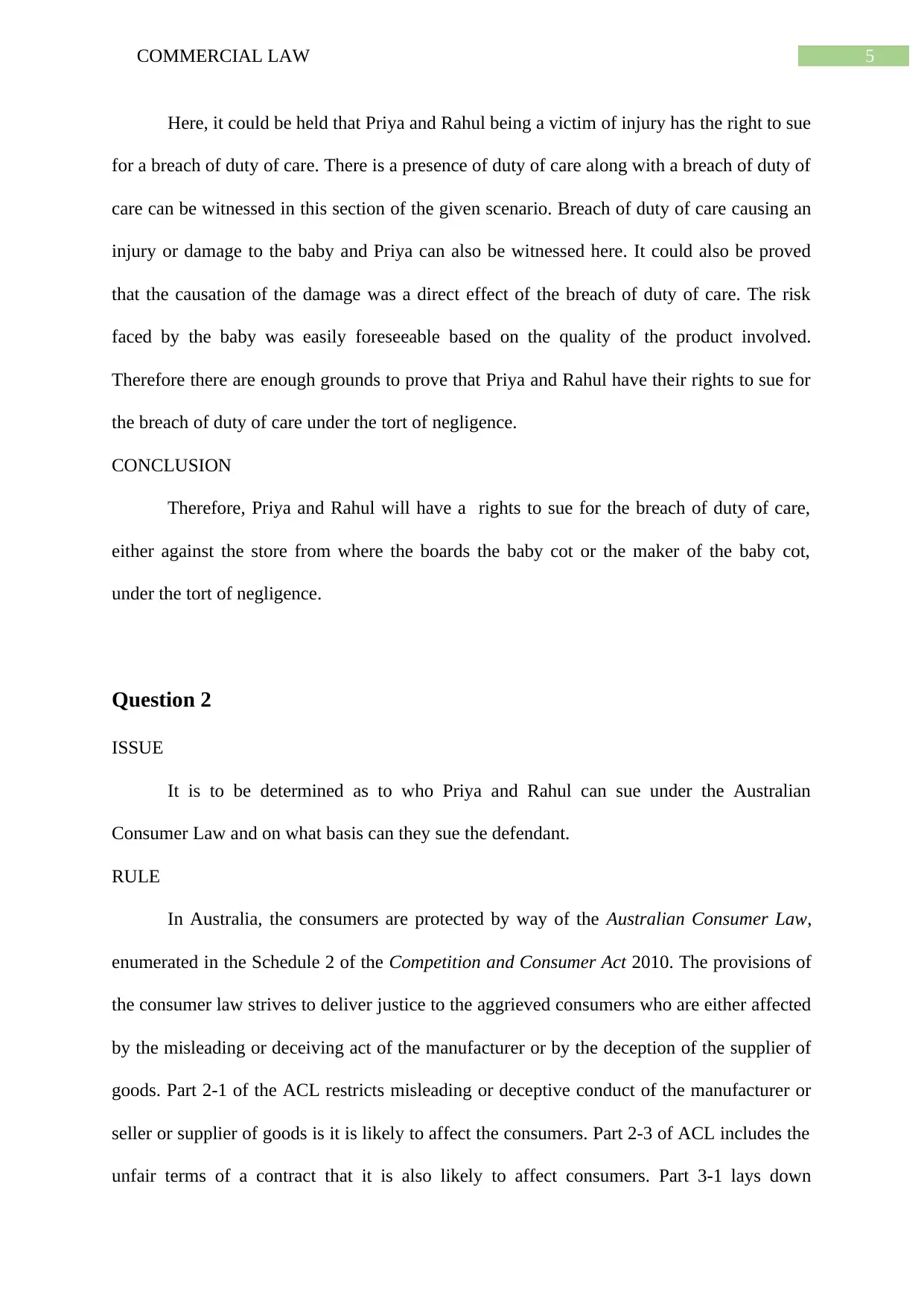
5COMMERCIAL LAW
Here, it could be held that Priya and Rahul being a victim of injury has the right to sue
for a breach of duty of care. There is a presence of duty of care along with a breach of duty of
care can be witnessed in this section of the given scenario. Breach of duty of care causing an
injury or damage to the baby and Priya can also be witnessed here. It could also be proved
that the causation of the damage was a direct effect of the breach of duty of care. The risk
faced by the baby was easily foreseeable based on the quality of the product involved.
Therefore there are enough grounds to prove that Priya and Rahul have their rights to sue for
the breach of duty of care under the tort of negligence.
CONCLUSION
Therefore, Priya and Rahul will have a rights to sue for the breach of duty of care,
either against the store from where the boards the baby cot or the maker of the baby cot,
under the tort of negligence.
Question 2
ISSUE
It is to be determined as to who Priya and Rahul can sue under the Australian
Consumer Law and on what basis can they sue the defendant.
RULE
In Australia, the consumers are protected by way of the Australian Consumer Law,
enumerated in the Schedule 2 of the Competition and Consumer Act 2010. The provisions of
the consumer law strives to deliver justice to the aggrieved consumers who are either affected
by the misleading or deceiving act of the manufacturer or by the deception of the supplier of
goods. Part 2-1 of the ACL restricts misleading or deceptive conduct of the manufacturer or
seller or supplier of goods is it is likely to affect the consumers. Part 2-3 of ACL includes the
unfair terms of a contract that it is also likely to affect consumers. Part 3-1 lays down
Here, it could be held that Priya and Rahul being a victim of injury has the right to sue
for a breach of duty of care. There is a presence of duty of care along with a breach of duty of
care can be witnessed in this section of the given scenario. Breach of duty of care causing an
injury or damage to the baby and Priya can also be witnessed here. It could also be proved
that the causation of the damage was a direct effect of the breach of duty of care. The risk
faced by the baby was easily foreseeable based on the quality of the product involved.
Therefore there are enough grounds to prove that Priya and Rahul have their rights to sue for
the breach of duty of care under the tort of negligence.
CONCLUSION
Therefore, Priya and Rahul will have a rights to sue for the breach of duty of care,
either against the store from where the boards the baby cot or the maker of the baby cot,
under the tort of negligence.
Question 2
ISSUE
It is to be determined as to who Priya and Rahul can sue under the Australian
Consumer Law and on what basis can they sue the defendant.
RULE
In Australia, the consumers are protected by way of the Australian Consumer Law,
enumerated in the Schedule 2 of the Competition and Consumer Act 2010. The provisions of
the consumer law strives to deliver justice to the aggrieved consumers who are either affected
by the misleading or deceiving act of the manufacturer or by the deception of the supplier of
goods. Part 2-1 of the ACL restricts misleading or deceptive conduct of the manufacturer or
seller or supplier of goods is it is likely to affect the consumers. Part 2-3 of ACL includes the
unfair terms of a contract that it is also likely to affect consumers. Part 3-1 lays down
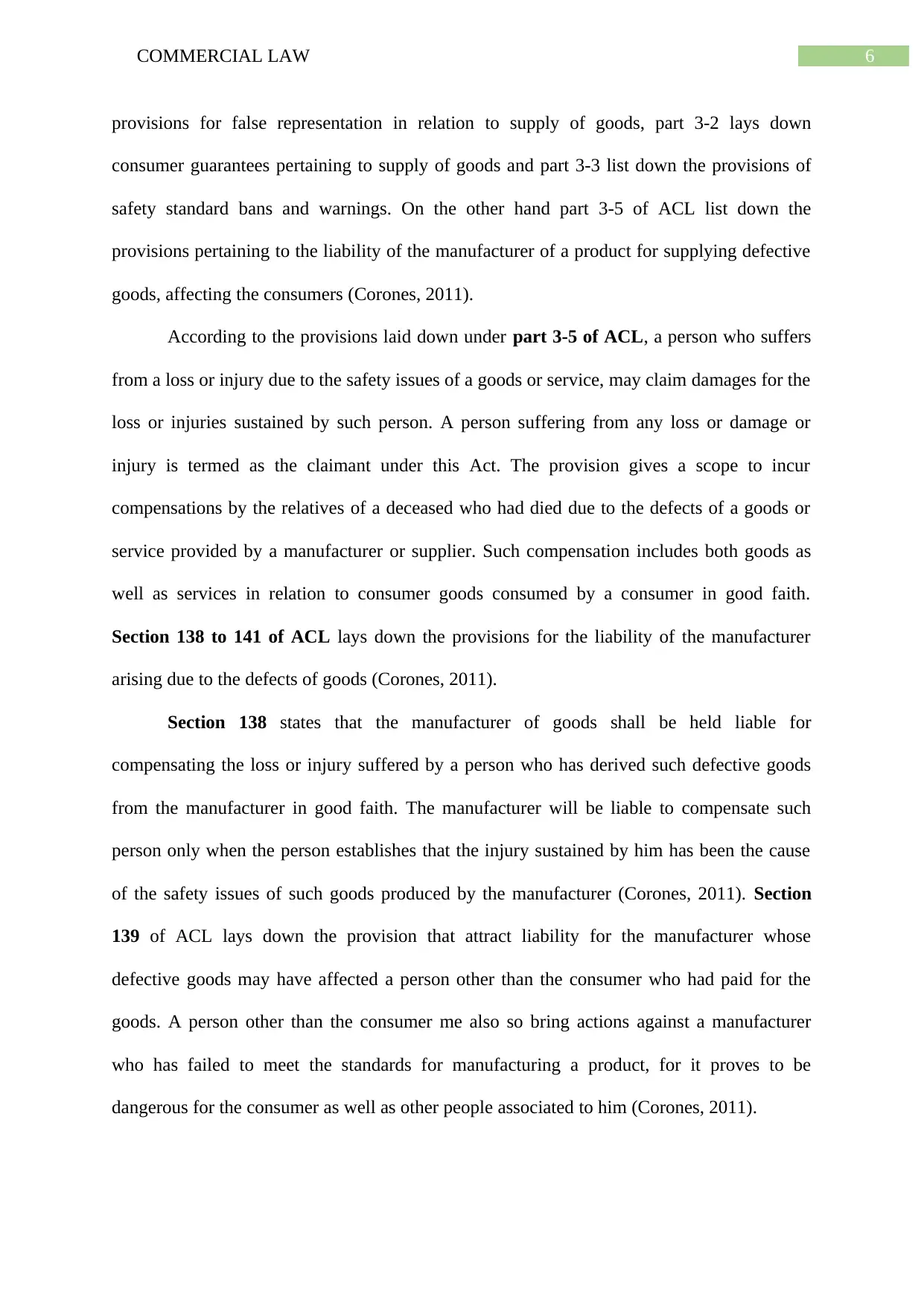
6COMMERCIAL LAW
provisions for false representation in relation to supply of goods, part 3-2 lays down
consumer guarantees pertaining to supply of goods and part 3-3 list down the provisions of
safety standard bans and warnings. On the other hand part 3-5 of ACL list down the
provisions pertaining to the liability of the manufacturer of a product for supplying defective
goods, affecting the consumers (Corones, 2011).
According to the provisions laid down under part 3-5 of ACL, a person who suffers
from a loss or injury due to the safety issues of a goods or service, may claim damages for the
loss or injuries sustained by such person. A person suffering from any loss or damage or
injury is termed as the claimant under this Act. The provision gives a scope to incur
compensations by the relatives of a deceased who had died due to the defects of a goods or
service provided by a manufacturer or supplier. Such compensation includes both goods as
well as services in relation to consumer goods consumed by a consumer in good faith.
Section 138 to 141 of ACL lays down the provisions for the liability of the manufacturer
arising due to the defects of goods (Corones, 2011).
Section 138 states that the manufacturer of goods shall be held liable for
compensating the loss or injury suffered by a person who has derived such defective goods
from the manufacturer in good faith. The manufacturer will be liable to compensate such
person only when the person establishes that the injury sustained by him has been the cause
of the safety issues of such goods produced by the manufacturer (Corones, 2011). Section
139 of ACL lays down the provision that attract liability for the manufacturer whose
defective goods may have affected a person other than the consumer who had paid for the
goods. A person other than the consumer me also so bring actions against a manufacturer
who has failed to meet the standards for manufacturing a product, for it proves to be
dangerous for the consumer as well as other people associated to him (Corones, 2011).
provisions for false representation in relation to supply of goods, part 3-2 lays down
consumer guarantees pertaining to supply of goods and part 3-3 list down the provisions of
safety standard bans and warnings. On the other hand part 3-5 of ACL list down the
provisions pertaining to the liability of the manufacturer of a product for supplying defective
goods, affecting the consumers (Corones, 2011).
According to the provisions laid down under part 3-5 of ACL, a person who suffers
from a loss or injury due to the safety issues of a goods or service, may claim damages for the
loss or injuries sustained by such person. A person suffering from any loss or damage or
injury is termed as the claimant under this Act. The provision gives a scope to incur
compensations by the relatives of a deceased who had died due to the defects of a goods or
service provided by a manufacturer or supplier. Such compensation includes both goods as
well as services in relation to consumer goods consumed by a consumer in good faith.
Section 138 to 141 of ACL lays down the provisions for the liability of the manufacturer
arising due to the defects of goods (Corones, 2011).
Section 138 states that the manufacturer of goods shall be held liable for
compensating the loss or injury suffered by a person who has derived such defective goods
from the manufacturer in good faith. The manufacturer will be liable to compensate such
person only when the person establishes that the injury sustained by him has been the cause
of the safety issues of such goods produced by the manufacturer (Corones, 2011). Section
139 of ACL lays down the provision that attract liability for the manufacturer whose
defective goods may have affected a person other than the consumer who had paid for the
goods. A person other than the consumer me also so bring actions against a manufacturer
who has failed to meet the standards for manufacturing a product, for it proves to be
dangerous for the consumer as well as other people associated to him (Corones, 2011).
Paraphrase This Document
Need a fresh take? Get an instant paraphrase of this document with our AI Paraphraser
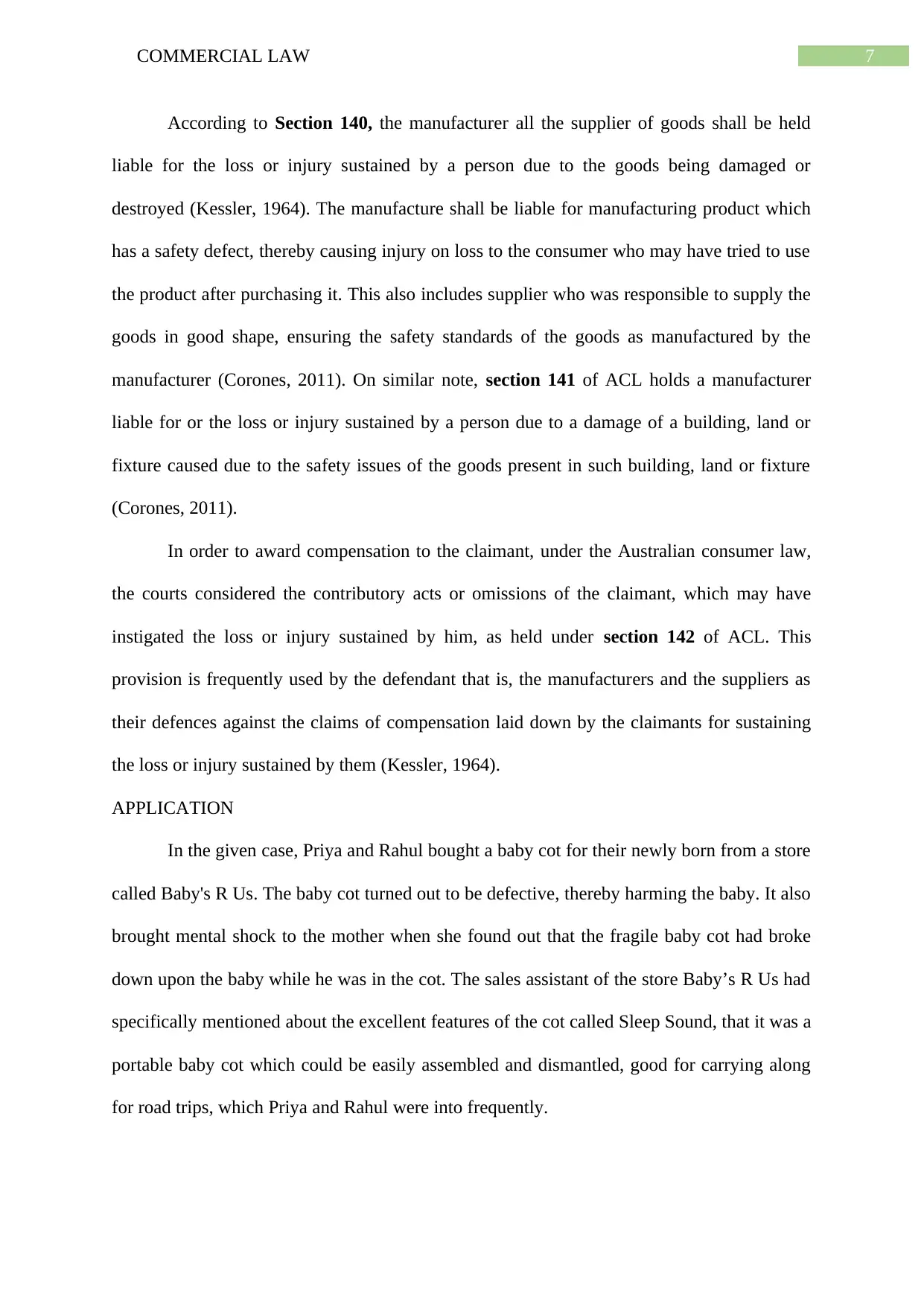
7COMMERCIAL LAW
According to Section 140, the manufacturer all the supplier of goods shall be held
liable for the loss or injury sustained by a person due to the goods being damaged or
destroyed (Kessler, 1964). The manufacture shall be liable for manufacturing product which
has a safety defect, thereby causing injury on loss to the consumer who may have tried to use
the product after purchasing it. This also includes supplier who was responsible to supply the
goods in good shape, ensuring the safety standards of the goods as manufactured by the
manufacturer (Corones, 2011). On similar note, section 141 of ACL holds a manufacturer
liable for or the loss or injury sustained by a person due to a damage of a building, land or
fixture caused due to the safety issues of the goods present in such building, land or fixture
(Corones, 2011).
In order to award compensation to the claimant, under the Australian consumer law,
the courts considered the contributory acts or omissions of the claimant, which may have
instigated the loss or injury sustained by him, as held under section 142 of ACL. This
provision is frequently used by the defendant that is, the manufacturers and the suppliers as
their defences against the claims of compensation laid down by the claimants for sustaining
the loss or injury sustained by them (Kessler, 1964).
APPLICATION
In the given case, Priya and Rahul bought a baby cot for their newly born from a store
called Baby's R Us. The baby cot turned out to be defective, thereby harming the baby. It also
brought mental shock to the mother when she found out that the fragile baby cot had broke
down upon the baby while he was in the cot. The sales assistant of the store Baby’s R Us had
specifically mentioned about the excellent features of the cot called Sleep Sound, that it was a
portable baby cot which could be easily assembled and dismantled, good for carrying along
for road trips, which Priya and Rahul were into frequently.
According to Section 140, the manufacturer all the supplier of goods shall be held
liable for the loss or injury sustained by a person due to the goods being damaged or
destroyed (Kessler, 1964). The manufacture shall be liable for manufacturing product which
has a safety defect, thereby causing injury on loss to the consumer who may have tried to use
the product after purchasing it. This also includes supplier who was responsible to supply the
goods in good shape, ensuring the safety standards of the goods as manufactured by the
manufacturer (Corones, 2011). On similar note, section 141 of ACL holds a manufacturer
liable for or the loss or injury sustained by a person due to a damage of a building, land or
fixture caused due to the safety issues of the goods present in such building, land or fixture
(Corones, 2011).
In order to award compensation to the claimant, under the Australian consumer law,
the courts considered the contributory acts or omissions of the claimant, which may have
instigated the loss or injury sustained by him, as held under section 142 of ACL. This
provision is frequently used by the defendant that is, the manufacturers and the suppliers as
their defences against the claims of compensation laid down by the claimants for sustaining
the loss or injury sustained by them (Kessler, 1964).
APPLICATION
In the given case, Priya and Rahul bought a baby cot for their newly born from a store
called Baby's R Us. The baby cot turned out to be defective, thereby harming the baby. It also
brought mental shock to the mother when she found out that the fragile baby cot had broke
down upon the baby while he was in the cot. The sales assistant of the store Baby’s R Us had
specifically mentioned about the excellent features of the cot called Sleep Sound, that it was a
portable baby cot which could be easily assembled and dismantled, good for carrying along
for road trips, which Priya and Rahul were into frequently.
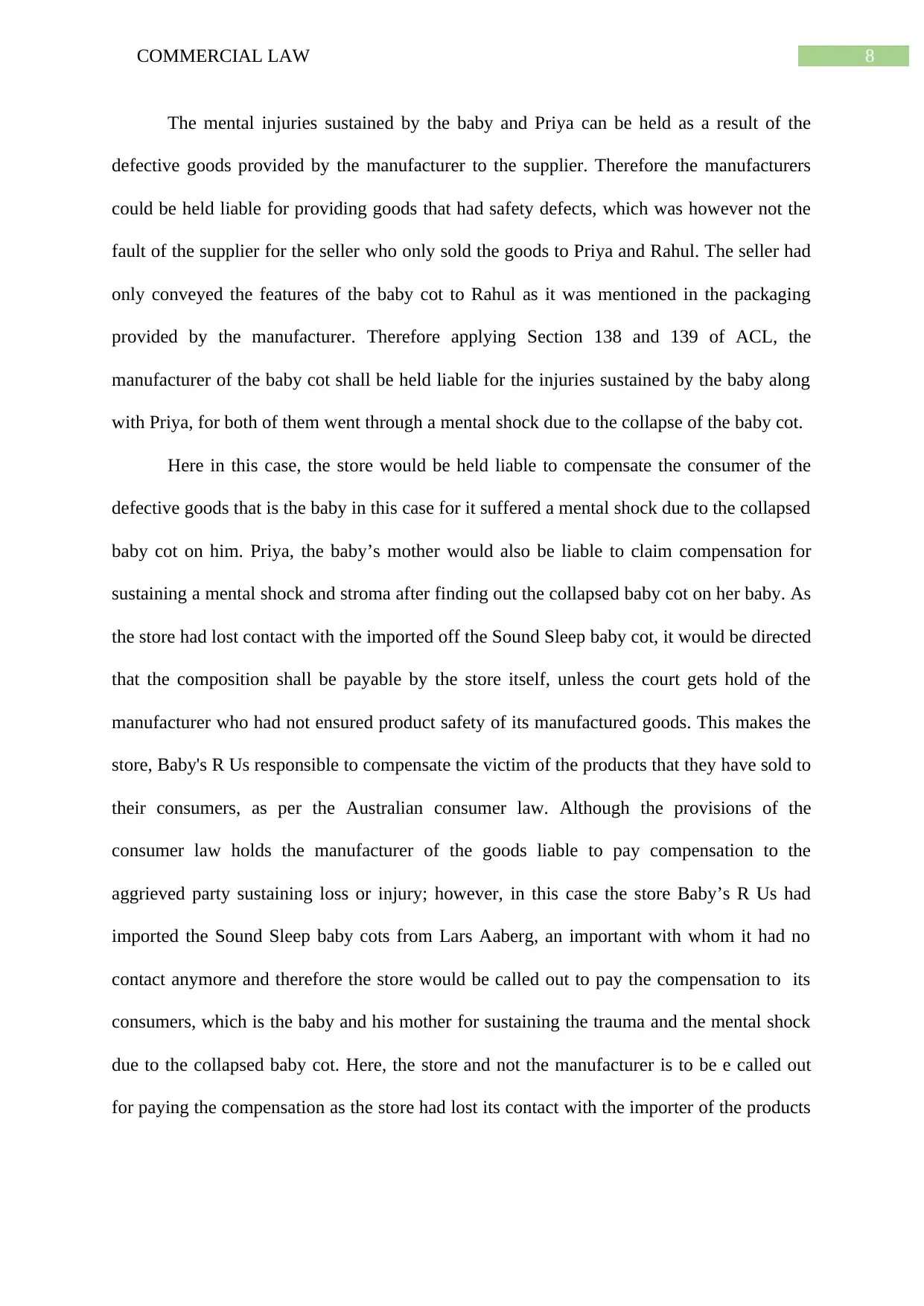
8COMMERCIAL LAW
The mental injuries sustained by the baby and Priya can be held as a result of the
defective goods provided by the manufacturer to the supplier. Therefore the manufacturers
could be held liable for providing goods that had safety defects, which was however not the
fault of the supplier for the seller who only sold the goods to Priya and Rahul. The seller had
only conveyed the features of the baby cot to Rahul as it was mentioned in the packaging
provided by the manufacturer. Therefore applying Section 138 and 139 of ACL, the
manufacturer of the baby cot shall be held liable for the injuries sustained by the baby along
with Priya, for both of them went through a mental shock due to the collapse of the baby cot.
Here in this case, the store would be held liable to compensate the consumer of the
defective goods that is the baby in this case for it suffered a mental shock due to the collapsed
baby cot on him. Priya, the baby’s mother would also be liable to claim compensation for
sustaining a mental shock and stroma after finding out the collapsed baby cot on her baby. As
the store had lost contact with the imported off the Sound Sleep baby cot, it would be directed
that the composition shall be payable by the store itself, unless the court gets hold of the
manufacturer who had not ensured product safety of its manufactured goods. This makes the
store, Baby's R Us responsible to compensate the victim of the products that they have sold to
their consumers, as per the Australian consumer law. Although the provisions of the
consumer law holds the manufacturer of the goods liable to pay compensation to the
aggrieved party sustaining loss or injury; however, in this case the store Baby’s R Us had
imported the Sound Sleep baby cots from Lars Aaberg, an important with whom it had no
contact anymore and therefore the store would be called out to pay the compensation to its
consumers, which is the baby and his mother for sustaining the trauma and the mental shock
due to the collapsed baby cot. Here, the store and not the manufacturer is to be e called out
for paying the compensation as the store had lost its contact with the importer of the products
The mental injuries sustained by the baby and Priya can be held as a result of the
defective goods provided by the manufacturer to the supplier. Therefore the manufacturers
could be held liable for providing goods that had safety defects, which was however not the
fault of the supplier for the seller who only sold the goods to Priya and Rahul. The seller had
only conveyed the features of the baby cot to Rahul as it was mentioned in the packaging
provided by the manufacturer. Therefore applying Section 138 and 139 of ACL, the
manufacturer of the baby cot shall be held liable for the injuries sustained by the baby along
with Priya, for both of them went through a mental shock due to the collapse of the baby cot.
Here in this case, the store would be held liable to compensate the consumer of the
defective goods that is the baby in this case for it suffered a mental shock due to the collapsed
baby cot on him. Priya, the baby’s mother would also be liable to claim compensation for
sustaining a mental shock and stroma after finding out the collapsed baby cot on her baby. As
the store had lost contact with the imported off the Sound Sleep baby cot, it would be directed
that the composition shall be payable by the store itself, unless the court gets hold of the
manufacturer who had not ensured product safety of its manufactured goods. This makes the
store, Baby's R Us responsible to compensate the victim of the products that they have sold to
their consumers, as per the Australian consumer law. Although the provisions of the
consumer law holds the manufacturer of the goods liable to pay compensation to the
aggrieved party sustaining loss or injury; however, in this case the store Baby’s R Us had
imported the Sound Sleep baby cots from Lars Aaberg, an important with whom it had no
contact anymore and therefore the store would be called out to pay the compensation to its
consumers, which is the baby and his mother for sustaining the trauma and the mental shock
due to the collapsed baby cot. Here, the store and not the manufacturer is to be e called out
for paying the compensation as the store had lost its contact with the importer of the products
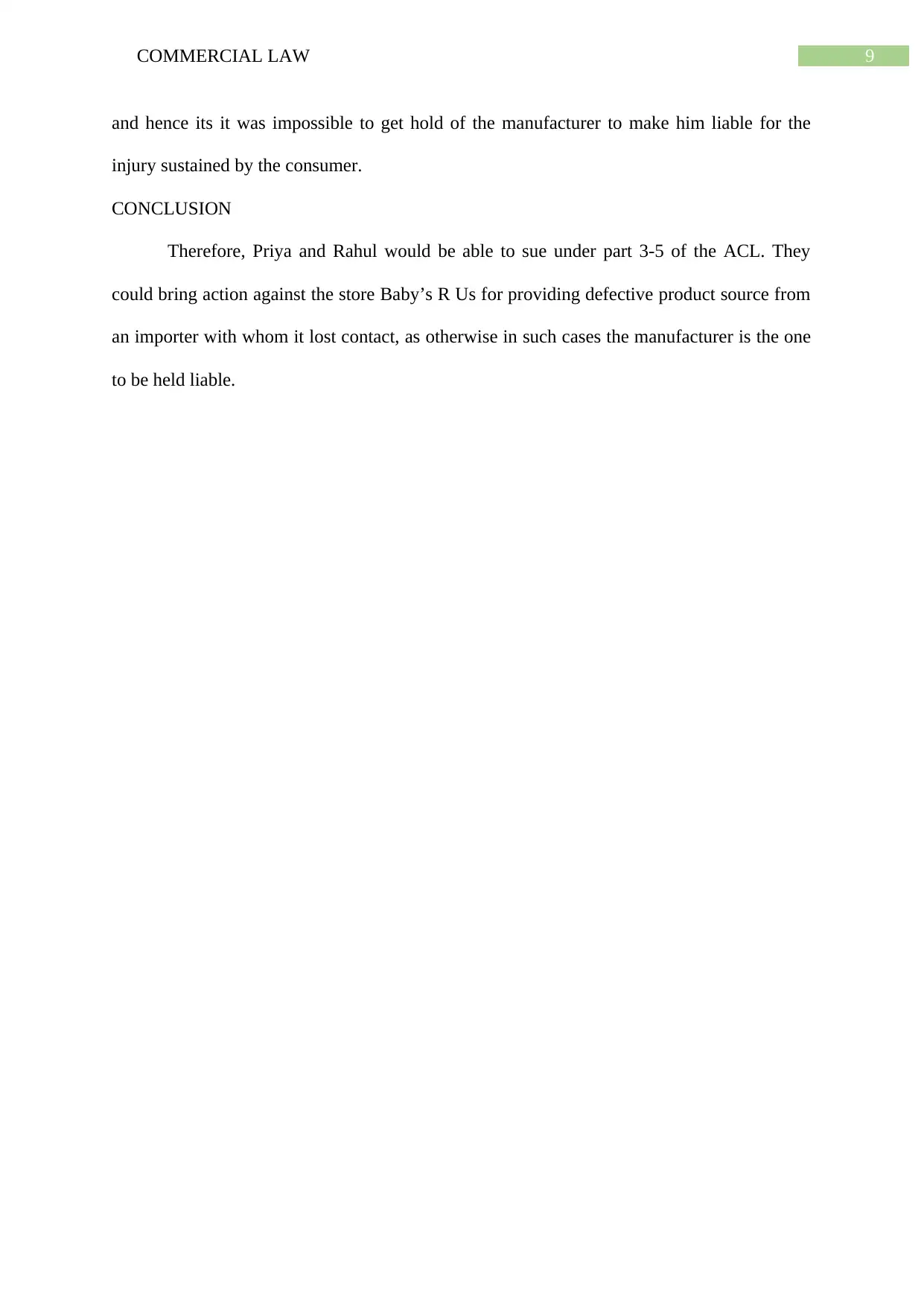
9COMMERCIAL LAW
and hence its it was impossible to get hold of the manufacturer to make him liable for the
injury sustained by the consumer.
CONCLUSION
Therefore, Priya and Rahul would be able to sue under part 3-5 of the ACL. They
could bring action against the store Baby’s R Us for providing defective product source from
an importer with whom it lost contact, as otherwise in such cases the manufacturer is the one
to be held liable.
and hence its it was impossible to get hold of the manufacturer to make him liable for the
injury sustained by the consumer.
CONCLUSION
Therefore, Priya and Rahul would be able to sue under part 3-5 of the ACL. They
could bring action against the store Baby’s R Us for providing defective product source from
an importer with whom it lost contact, as otherwise in such cases the manufacturer is the one
to be held liable.
Secure Best Marks with AI Grader
Need help grading? Try our AI Grader for instant feedback on your assignments.
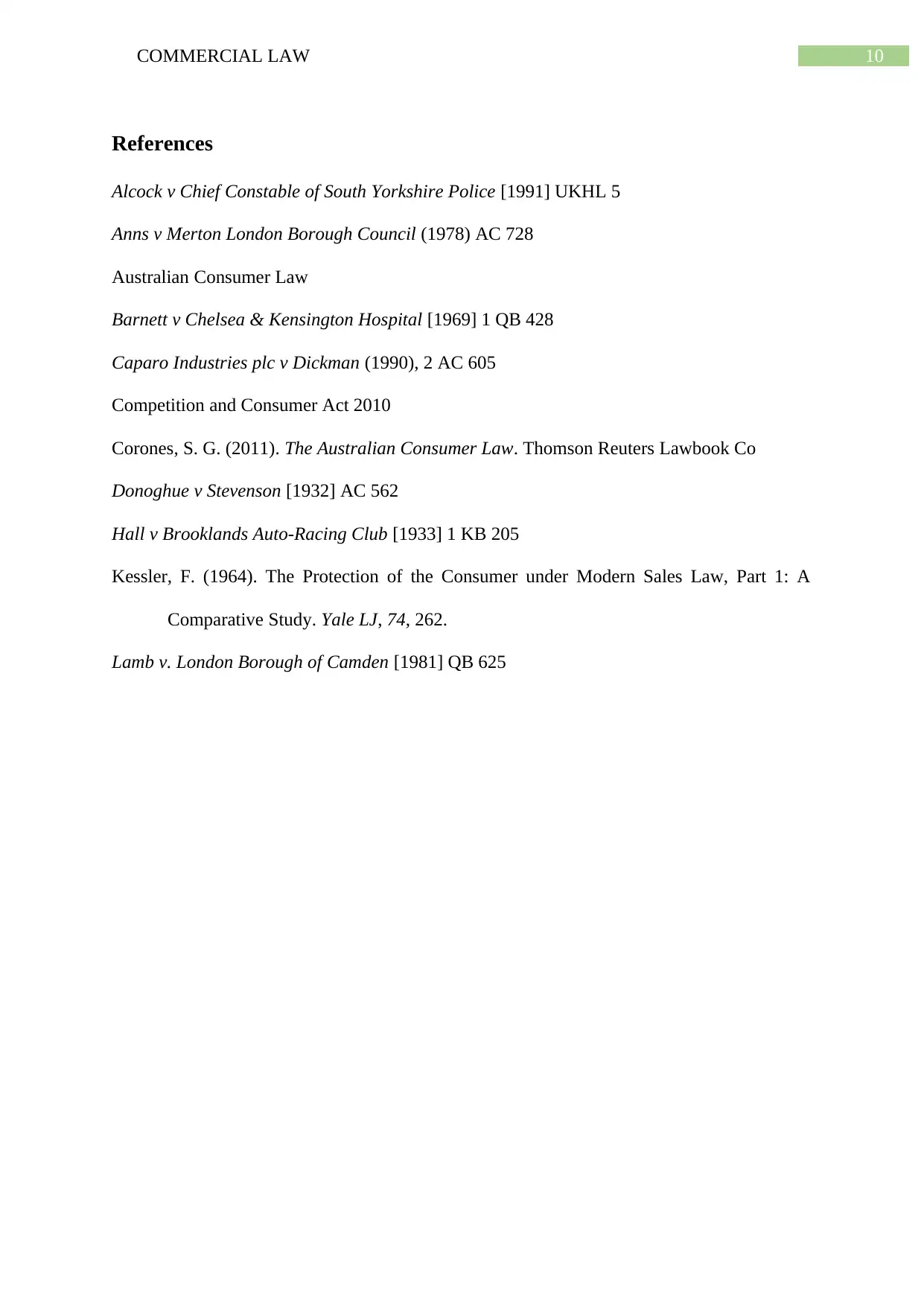
10COMMERCIAL LAW
References
Alcock v Chief Constable of South Yorkshire Police [1991] UKHL 5
Anns v Merton London Borough Council (1978) AC 728
Australian Consumer Law
Barnett v Chelsea & Kensington Hospital [1969] 1 QB 428
Caparo Industries plc v Dickman (1990), 2 AC 605
Competition and Consumer Act 2010
Corones, S. G. (2011). The Australian Consumer Law. Thomson Reuters Lawbook Co
Donoghue v Stevenson [1932] AC 562
Hall v Brooklands Auto-Racing Club [1933] 1 KB 205
Kessler, F. (1964). The Protection of the Consumer under Modern Sales Law, Part 1: A
Comparative Study. Yale LJ, 74, 262.
Lamb v. London Borough of Camden [1981] QB 625
References
Alcock v Chief Constable of South Yorkshire Police [1991] UKHL 5
Anns v Merton London Borough Council (1978) AC 728
Australian Consumer Law
Barnett v Chelsea & Kensington Hospital [1969] 1 QB 428
Caparo Industries plc v Dickman (1990), 2 AC 605
Competition and Consumer Act 2010
Corones, S. G. (2011). The Australian Consumer Law. Thomson Reuters Lawbook Co
Donoghue v Stevenson [1932] AC 562
Hall v Brooklands Auto-Racing Club [1933] 1 KB 205
Kessler, F. (1964). The Protection of the Consumer under Modern Sales Law, Part 1: A
Comparative Study. Yale LJ, 74, 262.
Lamb v. London Borough of Camden [1981] QB 625
1 out of 11
Related Documents
Your All-in-One AI-Powered Toolkit for Academic Success.
+13062052269
info@desklib.com
Available 24*7 on WhatsApp / Email
![[object Object]](/_next/static/media/star-bottom.7253800d.svg)
Unlock your academic potential
© 2024 | Zucol Services PVT LTD | All rights reserved.





